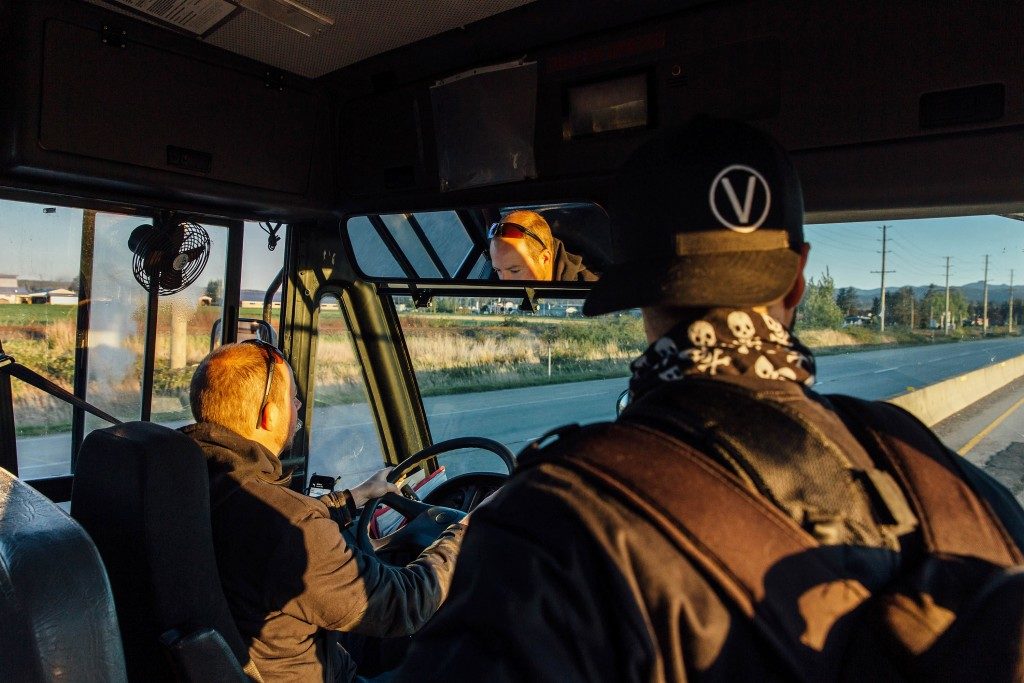Testing the Line: As Animal Rights Activists Push Legal Boundaries, Canada Considers What Makes a Terrorist
ANGLO AMERICA, JUSTICE, ANIMAL RIGHTS - VEGETARIANISM, 20 May 2019
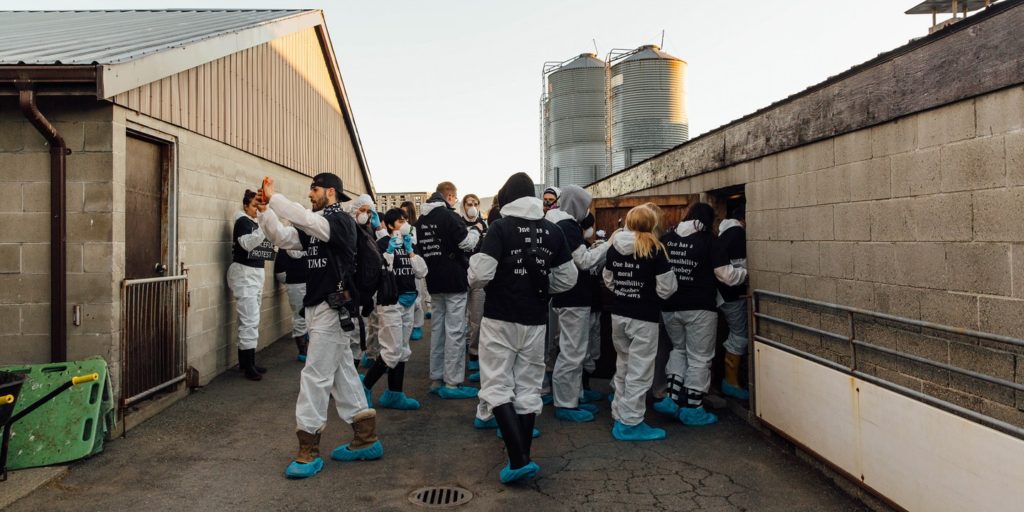
Members of Meat the Victims enter the Excelsior Hog Farm in Abbotsford, British Columbia, on April 28, 2019.
Photo: Jackie Dives for The Intercept
12 May 2019 – A flashlight illuminates the blackened, detached head and leg of a pig’s corpse as they’re nudged and nibbled by living pigs. The camera captures another pig lying listlessly on its side and twitching. Some are afflicted with large growths, one on its belly, another near its eye. The footage, released by People for the Ethical Treatment of Animals, was provided by anonymous activists who say it depicts the Excelsior Hog Farm in Abbotsford, British Columbia.
Four days after the release of the PETA footage, 25-year-old Amy Soranno, a former teen beauty queen with blue hair and meticulous makeup, sat at the front of a packed school bus, tensely looking back at 65 vegan activists dressed in white bio-suits fit to protect livestock from human-borne disease. Outside, fog hovered over fields framed by blue mountains, as the early morning sky yellowed. They were on their way to the Excelsior farm.
Soranno and the others were acting as part of a movement called Meat the Victims, which began in Australia. A standard action involves dozens of activists descending on an animal farm. While one group stands on a public road in front of the farm, another group stages a sit-in inside the animal facility.
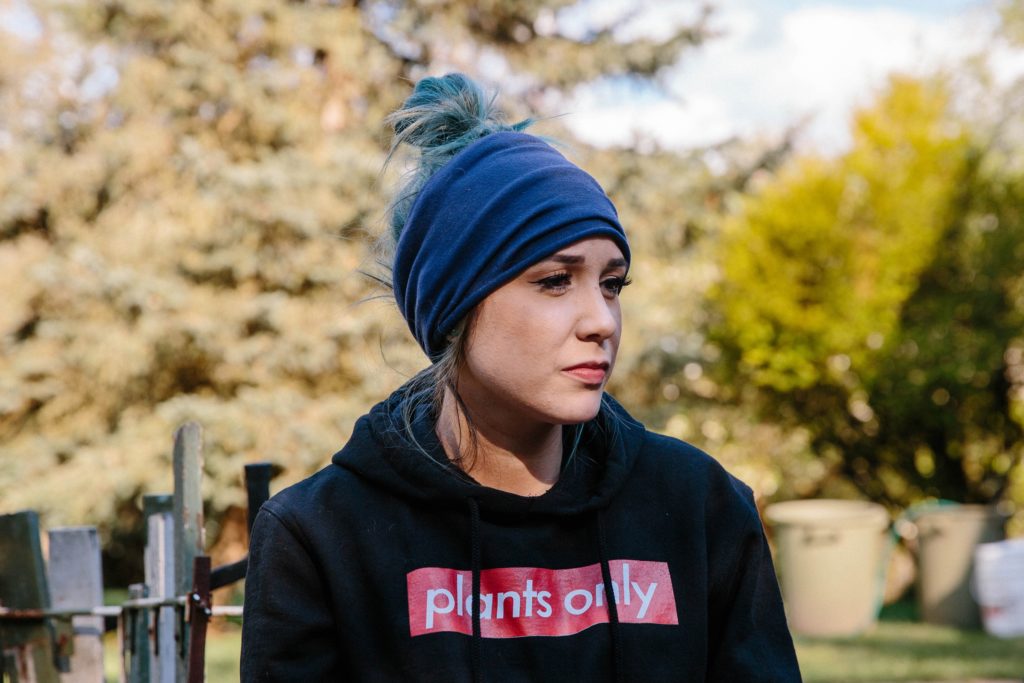
Amy Soranno in Aldergrove, British Columbia, on April 28, 2019. Photo: Jackie Dives for The Intercept
Soranno had participated in audacious actions before. As an organizer with Okanagan Animal Save, she has set up “vigils” where participants wave down trucks headed to slaughterhouses so that they can take the animals’ photos and comfort them before they’re killed. She has also performed “open rescues,” where she entered chicken farming facilities and removed birds for rehabilitation. All of this has been broadcast to her more than 25,000 Instagram followers. That day, she was acting as a safety marshal for the action, liaising with police and making sure the group didn’t do anything to endanger themselves or the animals.
It was clear that someone had alerted farmers in the area that something was about to happen. Ray Binnendyk, the hog farm’s owner, had parked an excavator across the dirt access road the activists intended to use to approach the property, and one of the activists had spotted private security nearby.
As the activists descended from the bus into the sharp-smelling air, several began Instagram livestreams. They tried a door and a window — locked. But then, to their surprise, a wide entrance to a squat cement building eased open. As they began leaping into the pig pen below, two pickup trucks careened down the narrow alley between buildings.
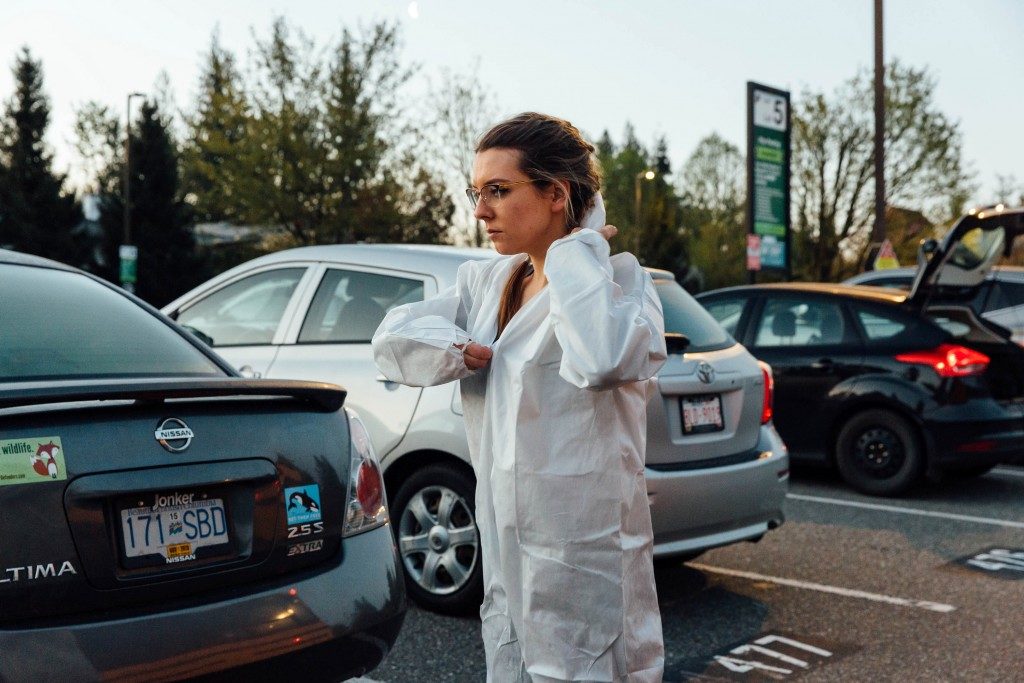
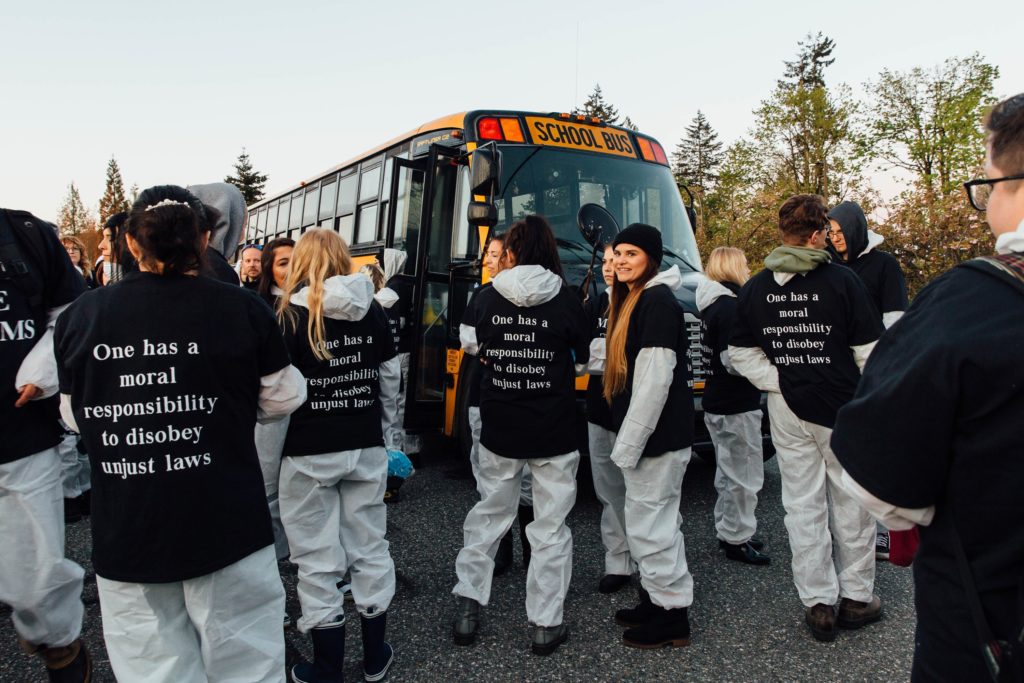 Activists prepare for their action before traveling by bus to the Excelsior Hog Farm in Abbotsford, British Columbia, on April 28, 2019.
Activists prepare for their action before traveling by bus to the Excelsior Hog Farm in Abbotsford, British Columbia, on April 28, 2019.
Photos: Jackie Dives for The Intercept
A disheveled-looking man with a white mustache and two younger farmers jumped from the trucks and rushed toward them.
“We’re peaceful!” the activists shouted as they rushed into the building.
“Private property — please leave!” the farmers shouted back, as they attempted to grab some of the protesters and shove them away from the entrance.
It was too late. Fifty people were in the building and on social media. Fifteen others circled the property taking photos through the windows. The farmers tried spraying those outside with a liquid manure spreader attached to a tractor, to no avail.
In front of the farm, two other buses arrived and more than 100 protesters lined up on either side of the highway singing, “Liiiiiberation — because we are all animals.” Police unrolled yellow tape in front of the modest farmhouse.
Dan Moskaluk, a vegan who recently retired from Canada’s national Royal Canadian Mounted Police, nodded, satisfied. “It looks like we’ve caught everybody flatfooted,” he said.
A Haphazard Animal Welfare System
Globally, a new generation of animal rights activism is finding its legs. Fueled by Instagram influencers, dramatic documentaries, and the threat of climate change, a rising number of vegan activists are turning to civil disobedience. The Meat the Victims action was the first of its kind in Canada, introducing the nation’s law enforcement to the growing community of citizens willing to creatively break the law to end animal exploitation.
In the U.S., animal industries have successfully lobbied for special legal penalties for those who trespass or capture footage on animal agriculture properties, with some laws going so far as to label animal rights activists as terrorists. Canada has not yet followed its neighbor’s lead, but this new trend of trespass-based protest is testing the line between Canada’s criminal justice system and private agricultural interests.
Binnendyk, a trim, pale-eyed Canadian with a weather-worn face, serves as co-director of the B.C. Pork Producers Association. In late March, he found a pair of cameras hidden in his barns. After PETA’s footage was released a few weeks later, the farmer told reporters, “We believe they were staged because some of those pictures couldn’t have been from our farm. We’re not sure.”
Another B.C. Pork Producers co-director, Chad Goertzen, said the footage “has been edited and lacks context and understanding, but some of the scenes are of concern.” Neither has explained which parts might be staged or what would explain the many corpses and illnesses. The Intercept’s requests for Binnendyk’s comment, submitted through B.C. Pork Producers, went unanswered, and a spokesperson for the association said they had no comment.
PETA’s footage was filmed with a handheld camera, but additional video provided to The Intercept by an activist who declined to be named includes footage from the installed surveillance cameras, which appears to include images of Binnendyk’s two brothers (the trio run the farm together). A shot captured by a drone begins inside a dumpster filled with pig bodies, then rises high enough to identify the Excelsior property.
In the wake of the release of the PETA footage, the British Columbia Society for the Prevention of Cruelty to Animals launched an investigation into the Excelsior Hog Farm, but many of the poor conditions depicted likely meet the industry’s standards.
When it comes to animal welfare, the Canadian agricultural industry polices itself. The code of practice that lays out acceptable animal treatment is developed by the National Farm Animal Care Council, whose decision makers are mostly industry associations. The most serious recent incidents of agricultural cruelty have been uncovered not by any public agency but by a nonprofit called Mercy for Animals, via undercover employment-based investigations.
In 2017, six workers for Chilliwack Cattle Sales were sentenced to between seven and 60 days in jail on animal cruelty charges. The company and its owner were fined nearly $350,000 in total. The severity of the penalties made the Chilliwack order a landmark decision among Canadian animal cruelty cases.
It’s unlikely that the abusers would have been held accountable if Mercy for Animals hadn’t sent an investigator equipped with a hidden camera to get a job at the facility. The bodycam footage shows employees kicking and punching cows in the head and rear, beating them with rods, and poking wounds. One live cow is lifted by its neck via a chain.
In British Columbia, enforcement of animal cruelty laws falls to the BC SPCA, a charity that receives no government funding. Although its 34 constables have the legal authority to conduct proactive investigations of animal facilities, they lack the budget to do more than respond to complaints, said Marcie Moriarty, the BC SPCA’s chief prevention and enforcement officer. The vast majority of the charity’s investigations involve pet or horse abuse — less than 10 percent of complaints are filed against farms, and most of those are hobby rather than commercial operations.
When Moriarty looks at undercover footage, she looks for signs that an animal is in distress — the PETA footage of a pig with its leg bent awkwardly backward, unable to walk, was a red flag, she said. Also worrisome were the dead animals left among the living. But she also has to show that the problem sits outside of agriculturalists’ generally accepted practices. If the animal was on a veterinary plan, or if the pen had been checked within the past 24 hours, the pig’s pain might have been legally permissible. Verifying footage adds an additional barrier. “Given what I currently understand about that video, it’s likely going to be challenging to see any charges as a result, due to that evidentiary requirement,” she said.
Asked what she expected from the Excelsior investigation, Anna Pippus, an animal welfare lawyer, replied, “Nothing.”
The goal, then, in publishing such footage is less to trigger penalties and more to shock the public into changing the system.
Although law enforcement falters in protecting animal welfare, guarding private property comes naturally. “Police are like, theft and trespassing — yes, we can do that; we know that,” said Pippus.
In the U.S., the federal Animal Enterprise Terrorism Act criminalizes “interference” in the activities of any entity with a connection to an animal enterprise, while state-level “ag-gag” laws make filming on an animal facility without consent a crime. “There’s nothing like that here,” said Pippus. Canadian animal rights activists have instead been charged with criminal mischief, breaking and entering, or trespassing.
At least some industry representatives have been unimpressed with the results. “The Canadian agriculture community as a whole has been faced with pig farm protests, lamb releases, pet store vandalism, mink releases, truck sabotage, economic sabotage, personal threats, and false information,” said Gary Hazelwood, executive director of the Canadian Mink Breeders Association, at an April 4 hearing for the House of Commons agriculture committee.
“We recommend the committee take a look at legislation in the United States entitled the Animal Enterprise Terrorism Act,” he said. “Allowing animal extremists and anti-agriculture groups to slander farmers’ names with untruths and doctored videos hurts all of agriculture. This can easily be remedied with the right legislation.”
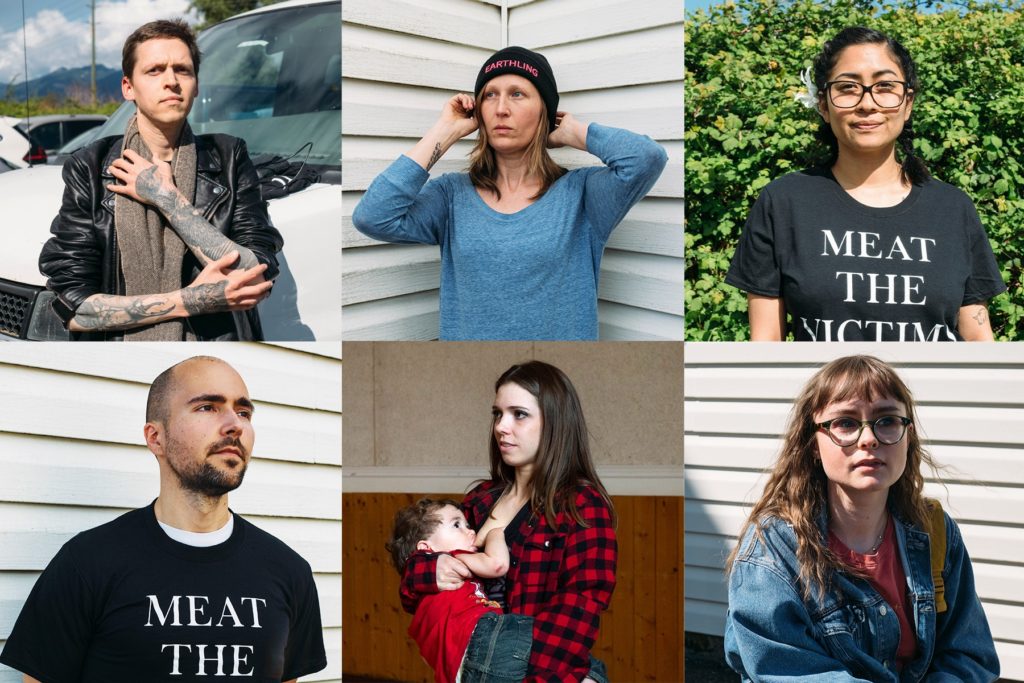
Animal rights activists at an organizational meeting for Meat the Victims on April 27, 2019, in Abbotsford, British Columbia. Photos: Jackie Dives for The Intercept
Creeping Discomfort
Animal rights activism wasn’t Dan Moskaluk’s first encounter with protesters. In 1997, he was on duty at the infamous Asia-Pacific Economic Cooperation Conference at Vancouver’s University of British Columbia, where protesters rallying against neoliberalism were blasted with pepper spray at close range by an RCMP officer, sparking a yearslong national inquiry.
Still, Moskaluk had a rosy image of the relationship between police and activists. “I’ve always been very satisfied and proud of the structure that the RCMP has put into place for activism,” he said.
In 2013, Moskaluk, by then an RCMP media spokesperson, was diagnosed with stage 4 kidney cancer. Told that he might have only months to live, Moskaluk began a strict plant-based diet. A year later, the cancer had gone into remission. He was featured in “Eating You Alive,” a 2016 documentary about using a vegan diet to cure disease, and it was a short step from there to activism. Moskaluk began attending Okanagan Animal Save vigils with Soranno.
Moskaluk soon became infected with a creeping discomfort with the way he noticed police interacting with industry. It started when he stumbled upon a January 2018 article in the Ontario Hog Farmer, titled “Extremist Tactics, and Farmers’ Rights.” The piece described a presentation given by Ontario Provincial Police Officer Lisa Kinnear at the Ontario Pork Congress’s annual meeting. Kinnear worked with the police department’s hate crimes unit and said she’d spent nine years monitoring animal rights activists.
Without citing a source, the article said that animal rights “extremism” had been designated as “left-wing terrorism.” Kinnear warned the hog farmers that things would only get worse. “The worst mistake we can make is to underestimate extremists,” she said, adding, “You may have to start a different way of thinking and prepare yourself for the things that are going to happen.”
“I was appalled as to what I was reading,” Moskaluk said. He complained to the Ontario police department and was assured that Kinnear would no longer be giving such presentations. The Ontario Provincial Police declined to respond to The Intercept’s requests for comment in time for publication.
In February 2018, a fellow animal rights activist gave Moskaluk the transcript of a recording he made during a session at the annual meeting of the Poultry Industry Council, titled “Considerations and Recommendations When Dealing With Animal Activists.”
The session was led by Ontario Provincial Police Constables Stan Goch and Michelle Cole, who explained that they worked for the Provincial Liaison Team, originally known as the Aboriginal Team. The team was formed after police shot and killed Ojibway protester Dudley George in 1995. After a national inquiry, a set of officers began attending protests in jeans and T-shirts, openly identifying as police, to coordinate between protesters, property owners, and public officials. Deemed successful, the mission expanded.
“We’re called on a regular basis now by Animal Save groups,” Cole explained. The officers stressed repeatedly that they’ve stayed neutral, but they also offered examples of how they’ve passed along the information obtained from activists to their industry adversaries.
“We check on your business, make a little plan, change the deliveries, or make sure your employees get in at a certain time,” Goch said. The idea was to assure that the activists did “not impede their business.”
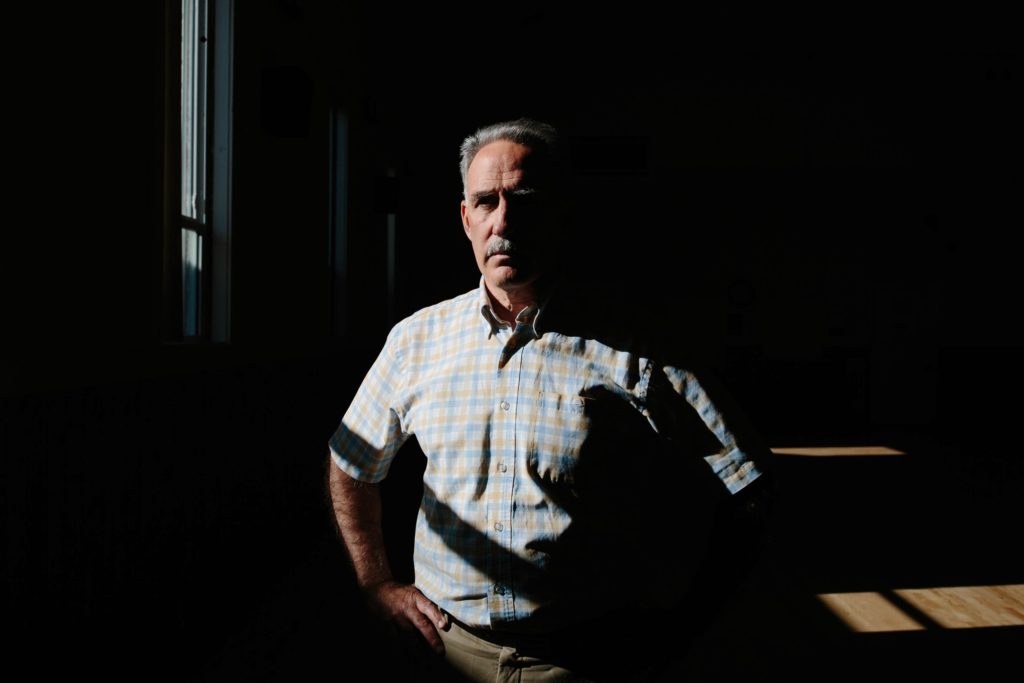
Dan Moskaluk in Abbotsford, British Columbia, on April 27, 2019. Photo: Jackie Dives for The Intercept
To Moskaluk, it seemed inappropriate for police to help industry avoid a peaceful protest.
The police duo underlined that not all activists were considered allies. “We’ll get our covert unit and our intelligence unit involved as well, in the event that there’s anarchists or people there just to cause trouble,” Cole said. The officers singled out Black Lives Matter as perennial troublemakers. Cole added that they sometimes advised activist groups to cancel events if “certain groups or individuals” planned to attend.
“Most of the people we deal with in animal rights are peaceful,” Goch said. “It’s the extremists who, more covertly, they go at night and let animals out or they take pictures of the conditions inside farms.”
Moskaluk was on his way out of the police force, set to retire in January 2019. He vowed that once he became a full-time activist, he would push the police to better serve community members engaged in protest and civil disobedience on behalf of animals.
Three days before Moskaluk retired, an RCMP briefing arrived in his inbox describing the Okanagan Animal Save group. At the bottom, it noted, “Information indicates one of the main organizers of the groups is a recently retired RCMP officer who will have knowledge of police techniques and media strategies.” The same day, he overheard a crime analyst describing how she had been tasked with monitoring the group’s social media pages because of escalating activism.
Moskaluk was incensed. “If I was involved with some other creed movement, be it sexual orientation or religious, and I was doing things lawfully,” he said, “they’re not going to say, yeah, there’s a gay rights activist in our section.”
But today’s LGBTQ rights movement isn’t primarily an anti-industry effort that features trespassing as a key tactic. For most of Canada’s history, being gay has been dangerous and essentially illegal, and protesting in the community’s defense has indeed drawn aggressive police reactions.
As a 56-year-old, straight, white cop, Moskaluk was just coming to terms with what it means to be involved in an activist movement whose tactics are fundamentally misaligned with the law, and in effect, with the police.
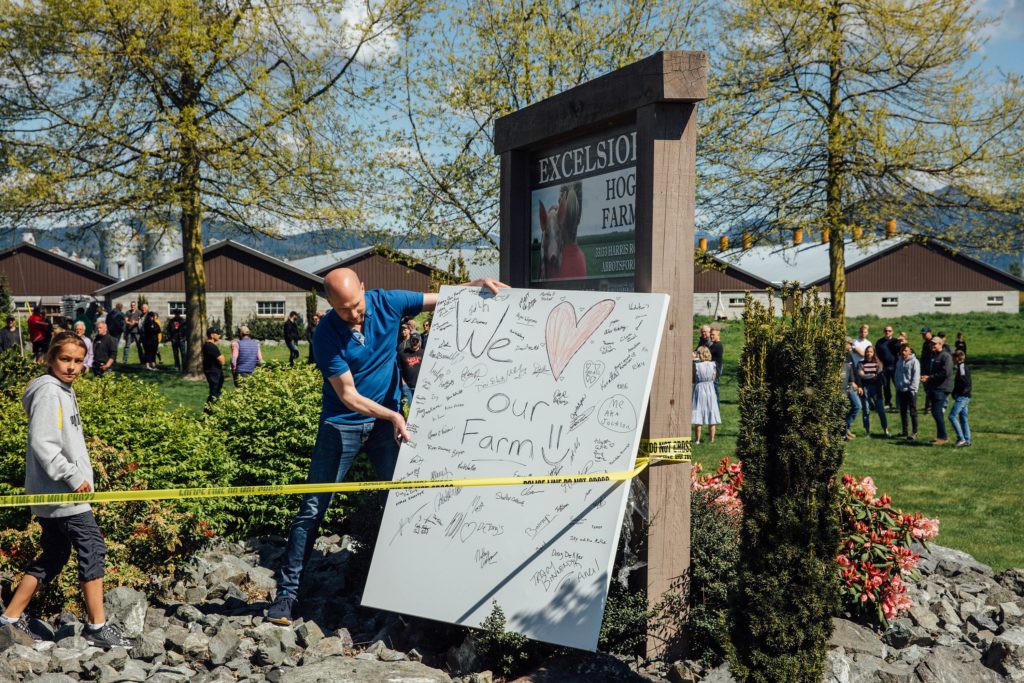
Supporters of the Excelsior Hog Farm display a sign with their signatures at the entrance to the farm on April 28, 2019. Photo: Jackie Dives for The Intercept
A Tour of the Barn
By mid-morning, farmers and neighbors began trickling onto Binnendyk’s property from a neighboring home. One carried a jug of coffee, another carried fast food from Tim Horton’s. Eventually, the crowd numbered more than 75.
Binnendyk agreed to the activists’ demand that members of the media be allowed to tour the hog farm. The Intercept was not invited. One of the farmers had spotted us arriving with the activists and assumed we were biased. CTV, Canada’s largest commercially owned network, which was the first to publish PETA’s footage, was also banned. A freelance videographer agreed to allow The Intercept to review what he filmed.
Binnendyk led the reporters from room to room, through spaces that looked similar to the undercover footage but lacked the cobwebs, corpses, and severely ill-looking animals. “We’re very proud of what we do,” he said.
Reporters were also invited to speak to Josh Waddington, the farm’s veterinarian. “There were some animals that might have been removed from the pen a little earlier,” he said of the footage. “In almost every production facility, there is a hospital area. … That’s what was shown.” Reporters were not shown the hospital area.
More worrisome to Waddington than the state of the animals in the footage, he said, was the issue of biosecurity. In past years, bird flu had obliterated poultry farms in the area. The vet was preparing to fly to a conference in Ottawa on the African swine flu, he said, “which has a huge component of agroterrorism. And that worries me, when I see these people in a barn in contact with animals.” He continued, “They don’t have an understanding, they don’t have awareness, and they might have an agenda.”
Judy Bird, the Abbotsford Police Department media spokesperson, told The Intercept that she generally doesn’t think of animal rights activists as terrorists. But, she added, “Him bringing that up is something that will rest in my mind.”
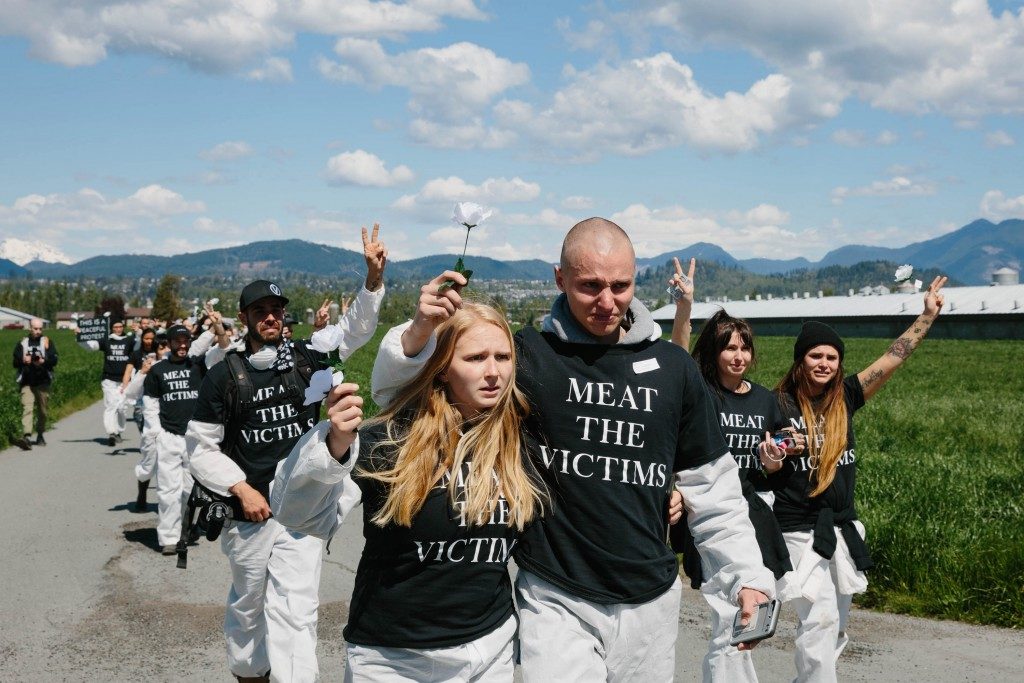
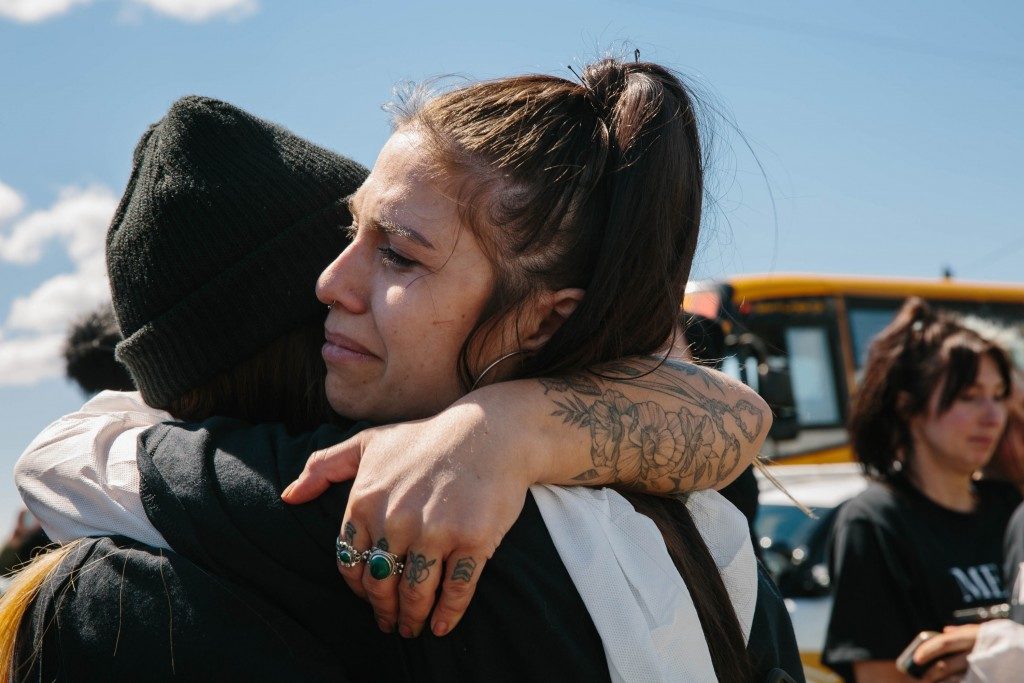 After exiting the Excelsior Hog Farm, activists cry and embrace.
After exiting the Excelsior Hog Farm, activists cry and embrace.
Photos: Jackie Dives for The Intercept
As the media tour wound down, the farm families migrated to the lawn in front of the highway. They brought out a giant white poster board, on which one of them wrote, “We [heart] Our Farm.” The children there signed it, and one of the men propped it in the driveway.
Seven hours after they’d entered the facility, the animal rights activists finally returned down the dirt access road at 1:30 p.m. Many of them were weeping, overwhelmed by the conditions in which the pigs, intelligent animals known to display a range of emotions, would spend the rest of their short lives. They had been arrested and processed on site, and sent home with orders to return for court dates.
The only one missing was Soranno. Suspected of being a leader and having something to do with the undercover footage, she’d been taken to the station, where her phone was confiscated. The police told her that if she provided them with her password, she’d get her phone back in a week. If she didn’t, they’d break into it anyway, and it would be a month or two before the phone was returned. She gave the police her password.
___________________________________________________
Related:
- How a Movement That Never Killed Anyone Became the FBI’s No. 1 Domestic Terrorism Threat
- Introducing “Animal Matters,” Our New Video Series About Animal Rights, Factory Farms, and the Agriculture Industry
Alleen Brown – alleen.brown@theintercept.com
Go to Original – theintercept.com
Tags: Activism, Animal Justice, Animal rights, Animals, Capitalism, Conflict, Cruelty, Exploitation, Justice, Politics, Power, Veganism, Vegetarianism, Violence, World
DISCLAIMER: The statements, views and opinions expressed in pieces republished here are solely those of the authors and do not necessarily represent those of TMS. In accordance with title 17 U.S.C. section 107, this material is distributed without profit to those who have expressed a prior interest in receiving the included information for research and educational purposes. TMS has no affiliation whatsoever with the originator of this article nor is TMS endorsed or sponsored by the originator. “GO TO ORIGINAL” links are provided as a convenience to our readers and allow for verification of authenticity. However, as originating pages are often updated by their originating host sites, the versions posted may not match the versions our readers view when clicking the “GO TO ORIGINAL” links. This site contains copyrighted material the use of which has not always been specifically authorized by the copyright owner. We are making such material available in our efforts to advance understanding of environmental, political, human rights, economic, democracy, scientific, and social justice issues, etc. We believe this constitutes a ‘fair use’ of any such copyrighted material as provided for in section 107 of the US Copyright Law. In accordance with Title 17 U.S.C. Section 107, the material on this site is distributed without profit to those who have expressed a prior interest in receiving the included information for research and educational purposes. For more information go to: http://www.law.cornell.edu/uscode/17/107.shtml. If you wish to use copyrighted material from this site for purposes of your own that go beyond ‘fair use’, you must obtain permission from the copyright owner.
Read more
Click here to go to the current weekly digest or pick another article:
ANGLO AMERICA:
- Who’s the Real Outlaw at Sea? Trump’s Tanker Grab or the Houthis’ Anti-Genocide Blockade?
- ‘We Want It Back’: Trump Asserts U.S. Claims to Venezuelan Oil and Land
- Judge, Jury, and Executioner: On U.S. Assassination Policy 1975-2025
JUSTICE:
- Int’l Court of Justice Finds Israelis Broke Law by Starving Palestinians of Gaza
- Gaza Tribunal: A Historic Statement in the Shadow of Testimony
- Bertrand Russell's Historic War Crimes Tribunal against the US in Vietnam, 1964-1967
ANIMAL RIGHTS - VEGETARIANISM:
